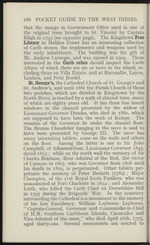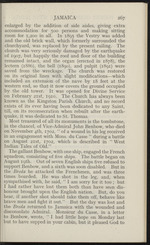| 1 |
 |
“...George’s and
St. Andrew’s, and until 1881 the Parish Church of those
two parishes, which are divided in Kingstown by the
North River, is reached by a walk of almond trees, many
of which are eighty years old. It has three fine lancet
windows in the chancel presented by the widow of
Lieutenant-Governor Dundas, who died in 1880, which
are supposed to have been the work of Kempe. The
remains of the Governor he under the chancel floor.
The Bronze Chandelier hanging in the nave is said to
have been presented by George III. The nave has
many interesting tablets, some on the walls and others
on the floor. Among the latter is one to Sir Johfi
Campbell, of Adnamurchan, Lieutenant-Governor 1845,
dated 1853 ; while on the north wall the memory of Sir
Charles Brisbane, Rear-Admiral of the Red, the victor
of Curasao in 1807, who was Governor from 1808 until
his death in 1829, is perpetuated. Other tablets per-
petuate the memory of Peter Beckett (1789); Major
Champion, of the 21st Royal Scots Fusiliers...”
|
|
| 2 |
 |
“...1,200 in all. In 1895 the Vestry was added
and the old brick wall, which formerly surrounded the
churchyard, was replaced by the present railing. The
church was very seriously damaged by the earthquake
of 1907, but happily the roof and floor of the buüding
remained intact, and the organ (erected in 1878), the
lectern (1886), the bell (1890), and pulpit (1891) were
saved from the wreckage. The church was restored
on its original lines with slight modifications—which
included an extension of the nave by 18 feet at the
western end, so that it now covers the ground occupied
by the old tower. It was opened for Divine Service
on February 21st, 1910. The Church has always been
known as the Kingston Parish Church, and no record
exists of its ever having been dedicated to any Saint,
till, on its reconsecration when rebuilt after the earth-
quake, it was dedicated to St. Thomas.
Most treasured of all its monuments is the tombstone,
in the chancel, of Vice-Admiral John Benbow, who died
on November...”
|
|
| 3 |
 |
“...274 POCKET GUIDE TO THE WEST INDIES
The parish church of St. Andrew, near by, like that at
Kingston, lost its tower as a result of the earthquake of
1907, and its nave has been extended westward over
the site of it. The first church was built on the old
burial-ground between Constant Spring Road and King’s
House. The second, which was built in 1685 near the
present site, was ruined by the earthquake of 1692. The
present church was completed in 1700, but it has been
much altered since then. The registers date back to
1666 and are the oldest in the island, though the earlier
ones are only a transcript. Though he was buried
in Kingston, Admiral Benbow’s burial is recorded in
the St. Andrew’s register. Among the monuments of
interest may be mentioned those of the Hon. James
Lawes (1733), by John Cheere, one of the best pieces of
iconic sculpture in the island; Zachary Bayly (1769),
with the epitaph by his nephew and heir, Bryan Edwards,
the historian; Admiral Davers (1746); and General
William...”
|
|
